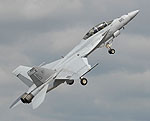Boeing to Showcase Super Hornet Simulator to Brazilian Congress and Public
 BRASILIA, Brazil, Aug. 15, 2011 -- Boeing [NYSE: BA] today announced that its Defense, Space & Security (BDS) business unit will showcase the F/A-18E/F Super Hornet Block II simulator inside the National Congress Building in Brasília from Aug. 16 through 19. The Brazilian public will be able to fly the simulator and see the advanced technology inside the Super Hornet.
BRASILIA, Brazil, Aug. 15, 2011 -- Boeing [NYSE: BA] today announced that its Defense, Space & Security (BDS) business unit will showcase the F/A-18E/F Super Hornet Block II simulator inside the National Congress Building in Brasília from Aug. 16 through 19. The Brazilian public will be able to fly the simulator and see the advanced technology inside the Super Hornet.
On Aug. 18, Boeing will participate in a public hearing organized by the National Defense Committee of the Brazilian Senate to discuss the Super Hornet's capabilities and how it meets the Brazilian Air Force's requirements, as well as technology transfer and industrial partnership.
"We look forward to answering any questions that the Brazilian senators may have in regard to Boeing's Super Hornet offering in the F-X2 fighter competition," said Joe McAndrew, BDS vice president of International Business Development for Europe, Israel and the Americas. "In addition to helping Brazil achieve air dominance, Boeing can be a strategic partner in several areas, including education, biofuels, satellites, unmanned systems, networking, and critical infrastructure protection."
The simulator includes a front and rear cockpit and demonstrates the capabilities of the single-seat E model and the two-seat F model. Its 180-degree projection screen offers virtual-reality visibility of cities, forests, roads and buildings, as well as enemy aircraft. The system is capable of demonstrating simulated aerial combat and air-to-ground targeting, navigation, and mission systems operation. Operators also can practice landing on and taking off from runways or an aircraft carrier.
The Super Hornet strike fighter is in service with the U.S. Navy and the Royal Australian Air Force and is currently one of the finalists in Brazil’s F-X2 fighter competition. The Super Hornet offers Brazil a winning combination of price and capability with advanced technology, high mission readiness, low life-cycle costs, low program risk, production availability, industrial benefits, and technology transfer.